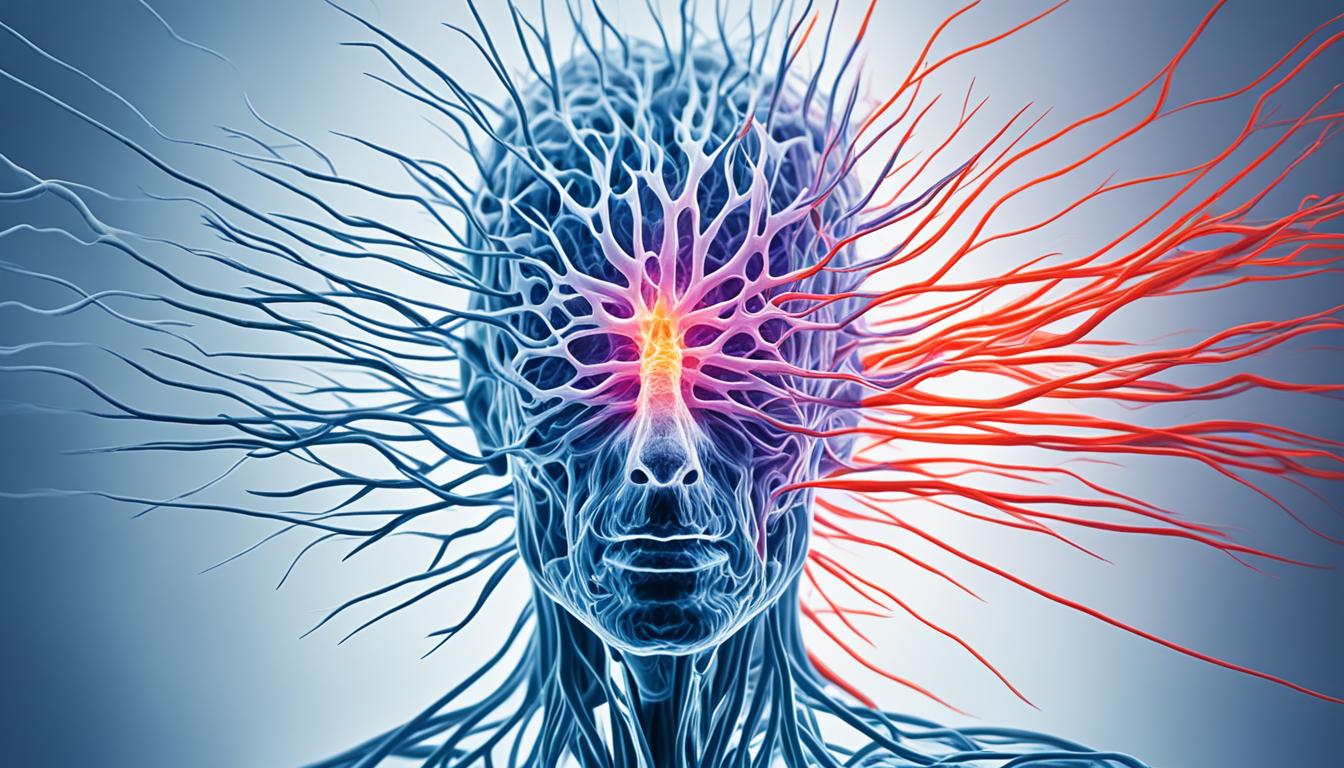Postherpetic neuralgia (PHN) is a long-lasting condition. It’s caused by the varicella-zoster virus (VZV), the same virus behind shingles. People with PHN feel a constant or burning pain along specific nerves. This pain can last for months after having shingles.
Factors like age, a weak immune system, and intense shingles pain play a role in getting PHN. The virus hides in nerve cells and wakes up, causing shingles. As we get older, our immune system can weaken, making PHN more likely. Roughly 13% of people over 50 who’ve had shingles will experience PHN. Having a family history of shingles adds to this risk.
Doctors diagnose PHN by looking at your medical history and doing a physical exam. They check for a past shingles rash and ongoing pain. Certain tests can show if your nerves are acting differently. Sometimes, more tests are needed to confirm the diagnosis.
PHN can be hard to treat, but there are several ways to help. Getting a vaccine can prevent shingles and PHN. It’s important to treat shingles early. This can stop PHN from happening. Doctors use different medicines and treatments to manage PHN symptoms. Stem cell therapy is a new area of research for treating PHN. It aims to repair nerve damage and reduce pain.
Doctors are excited about using stem cells to treat PHN. These cells can come from fat tissue or bone marrow. They help repair nerves and reduce swelling. More research is needed to know if this is a safe and effective treatment for PHN. But, early signs are good. Stem cell therapy might make life better for PHN patients.
Key Takeaways:
- Postherpetic neuralgia (PHN) is a chronic condition caused by the reactivation of the varicella-zoster virus (VZV), commonly known as shingles.
- PHN is characterized by persistent lancinating or burning pain that follows a specific pattern along the nerves.
- Risk factors for developing PHN include increasing age, immunosuppression, and severe pain during the shingles outbreak.
- Diagnosis of PHN is based on a thorough medical history, physical examination, and sometimes, additional diagnostic tests.
- Treatment approaches for PHN include prevention through vaccination, early recognition and treatment of acute shingles infection, and symptom management through multimodal medication regimens and interventional procedures.
- Stem cell therapy is being explored as a potential treatment option for PHN, with early studies showing promising results in promoting nerve healing and reducing inflammation.
Symptoms and Diagnosis of Postherpetic Neuralgia
Postherpetic neuralgia (PHN) causes lasting pain in an area after a herpes zoster outbreak. It’s key to spot symptoms and diagnose PHN early for good care.
The main sign of PHN is a sharp or burning pain, staying over three months post-herpes zoster. It affects one body side in a nerve pattern. Pain can range from mild to very severe, stopping daily tasks.
Symptoms of PHN also include:
- Sensitivity to light touch
- Itching
- Numbness in the affected area
These can make the condition very hard, lowering life quality.
Finding PHN is based on symptoms, physical checks, and ruling out other causes of pain. Doctors ask about past rashes in one side, tied to a previous herpes zoster. They look for ongoing pain, skin scarring, touch changes, and any nerve issues during the exam.
Also, allodynia (pain from gentle touch) might point to PHN. Further tests like imaging and labs could be used to confirm the diagnosis and check for other health issues.
Spotting PHN early is crucial to start the right treatments fast. This can help lower pain and boost the patient’s health.
Causes and Risk Factors of Postherpetic Neuralgia
Postherpetic neuralgia is ongoing pain from nerve damage during a shingles outbreak. Shingles result from the varicella-zoster virus (VZV), which causes chickenpox. Once you have chickenpox, the virus may become dormant and reappear later as shingles. This can lead to postherpetic neuralgia.
There are many elements that might make someone more likely to get postherpetic neuralgia. A few of these factors are:
- Increasing Age: The chance of getting postherpetic neuralgia goes up as you get older. Elderly people are at higher risk.
- Immunosuppression: If you have a condition or take medicine that lowers your immune system, like HIV/AIDS or chemotherapy, you’re more likely to develop postherpetic neuralgia.
- Severe Pain during the Shingles Outbreak: If your shingles pain was very bad or lasted a long time, it could mean you’re more at risk of postherpetic neuralgia.
- Presence of a Prodromal Phase: Feeling pain, tingling, or itching in the area where shingles later appears can also raise your risk.
- Allodynia: This is when you’re more sensitive to things that aren’t usually painful, like a light touch. It also predicts a higher chance of postherpetic neuralgia.
- Ophthalmic Involvement: If shingles affect your eye area, the risk of postherpetic neuralgia increases.
- Diabetes Mellitus: Having diabetes can impact your nerves and immune system, raising your risk for postherpetic neuralgia.
- Family History: If there’s a history of herpes zoster in your family, you might have a higher chance of getting postherpetic neuralgia.
By knowing about these causes and risks, we can find ways to detect, prevent, and treat postherpetic neuralgia early.
Stem Cell Therapy for Postherpetic Neuralgia
Stem cell therapy is a new hope for those living with postherpetic neuralgia (PHN). It uses mesenchymal stem cells from places like fat and bone marrow. These cells can turn into different cell types and make nerve-healing factors. This helps reduce pain and inflammation.
Early research shows good signs in lessening pain and bettering life for PHN patients. But, we still need more studies to know if stem cell therapy can be a main treatment for PHN. This is to check its effectiveness and safety well.
Doctors aim to change how we treat PHN by using the healing power of stem cells. This therapy might solve the big issues PHN brings. It aims to bring new hope to those who haven’t found relief with normal treatments.

